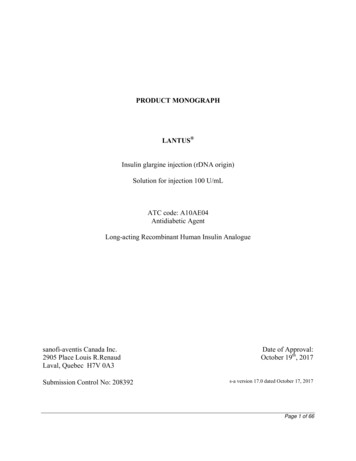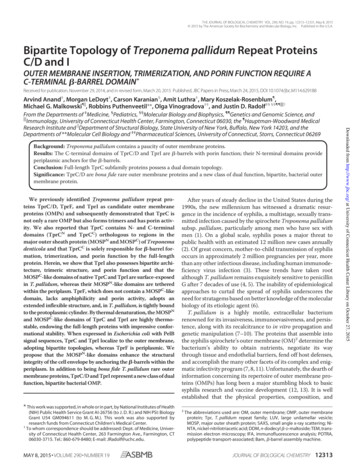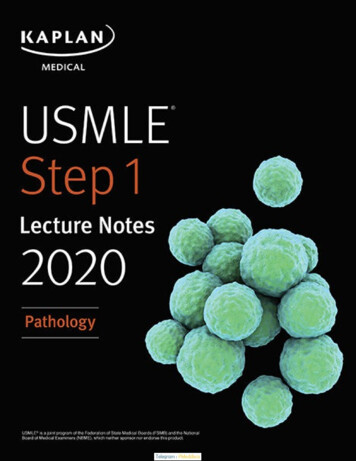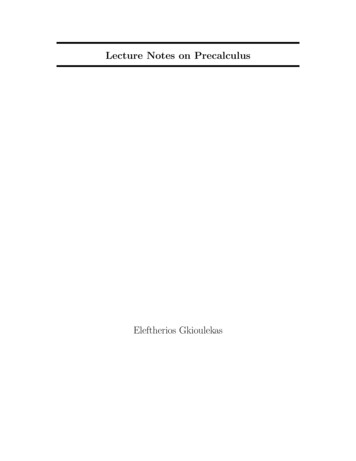
Transcription
CHAPTER 14 LECTURE NOTES: RECOMBINANT DNA TECHNOLOGYI.General InfoA. Landmarks in modern genetics1. Rediscovery of Mendel’s work2. Chromosomal theory of inheritance3. DNA as the genetic material4. Recombinant DNA technology development and applicationsB. Recombinant DNA refers to the creation of new combinations of DNA segments thatare not found together in nature. The isolation and manipulation of genes allows formore precise genetic analysis as well as practical applications in medicine, agriculture,and industry.C. Fundamental changes in our society are occurring as a result of genetic engineering.II.Making recombinant DNAOverview: Isolate DNA à Cut with restriction enzymes à Ligate into cloning vector àtransform recombinant DNA molecule into host cell à each transformed cell will dividemany, many times to form a colony of millions of cells, each of which carries therecombinant DNA molecule (DNA clone)(From: AN INTRODUCTION TO GENETIC ANALYSIS 6/E BY Griffiths, Miller, Suzuki,Leontin, Gelbart 1996 by W. H. Freeman and Company. Used with permission.)A. Isolating DNA1. Crude isolation of donor (foreign) DNA is accomplished by isolating cells àdisrupting lipid membranes with detergents à destroying proteins with phenol orproteases à degrading RNAs with RNase à leaving DNA at the end
2. Crude isolation of plasmid vector DNA is accomplished by an alkaline lysisprocedure or by boiling cells which removes bacterial chromosomal DNA fromplasmid DNA.3. To get purer DNA from either (1) or (2), crude DNA isa) Fractionated on a CsCl2 gradientb) Precipitated with ethanolc) Poured over a resin column that specifically binds DNAB. Cutting DNA1. DNA can be cut into large fragments by mechanical shearing.2. Restriction enzymes are the scissors of molecular genetics. Restrictionenzymes (RE) are endonucleases that will recognize specific nucleotide sequencesin the DNA and break the DNA chain at those points. A variety of RE have beenisolated and are commercially available. Most cut at specific palindromic sites inthe DNA (sequence that is the same on both antiparallel DNA strands). Thesecuts can be a staggered which generate “sticky or overhanging ends” or a bluntwhich generate flush ��--CTTAAAATTC--3’G--5’C. Joining DNAOnce you have isolated and cut the donor and vector DNAs, they must be joined together.The DNAs are mixed together in a tube. If both have been cut with the same RE, theends will match up because they are sticky. DNA ligase is the glue of molecular geneticsthat holds the ends of the DNAs together. DNA ligase creates a phosophodiester bondbetween two DNA ends.(From: AN INTRODUCTION TO GENETIC ANALYSIS 6/E BY Griffiths, Miller, Suzuki,Leontin, Gelbart 1996 by W. H. Freeman and Company. Used with permission.)
D. Amplifying the recombinant DNATo recover large amounts of the recombinant DNA molecule, it must be amplified. Thisis accomplished by transforming the recombinant DNA into a bacterial host strain. (Thecells are treated with CaCl2 à DNA is added à Cells are heat shocked at 42 C à DNAgoes into cell by a somewhat unknown mechanism.) Once in a cell, the recombinantDNA will be replicated. When the cell divides, the replicated recombinant molecules goto both daughter cells which themselves will divide later. Thus, the DNA is amplified.(From: AN INTRODUCTION TO GENETIC ANALYSIS 6/E BY Griffiths, Miller, Suzuki, Leontin,Gelbart 1996 by W. H. Freeman and Company. Used with permission.)DNA clone A section of DNA that has been inserted into a vector molecule and thenreplicated in a host cell to form many copies.E. Vectors1. Requirements for a cloning vectora) Should be capable of replicating in host cellb) Should have convenient RE sites for inserting DNA of interestc) Should have a selectable marker to indicate which host cells receivedrecombinant DNA moleculed) Should be small and easy to isolate
2. Bacterial plasmids are small, circular DNA molecules that are separate fromthe rest of the chromosome. They replicate independently of the bacterialchromosome. Useful for cloning DNA inserts less that 20 kb (kilobase pairs).Inserts larger than 20 kb are lost easily in the bacterial cell.(From: AN INTRODUCTION TO GENETIC ANALYSIS 6/E BY Griffiths, Miller, Suzuki,Leontin, Gelbart 1996 by W. H. Freeman and Company. Used with permission.)3. Bacteriophage lambda (45 kb) contains a central region of 15 kb that is notrequired for replication or formation of progeny phage in E. coli. Thus, lambdacan be used as a cloning vector by replacing the central 15 kb with 10-15 kb offoreign DNA. This is done as follows: mix RE cut donor DNA and lambda DNAin test tube à ligate à use in vitro packaging mix that will assemble progenyphage carrying the foreign DNA à infect E. coli with the phage to amplify
(From: AN INTRODUCTION TO GENETIC ANALYSIS 6/E BY Griffiths, Miller, Suzuki,Leontin, Gelbart 1996 by W. H. Freeman and Company. Used with permission.)4. Cosmids are hybrids of phages and plasmids that can carry DNA fragments upto 45 kb. They can replicate like plasmids but can be packaged like phagelambda.(From: AN INTRODUCTION TO GENETIC ANALYSIS 6/E BY Griffiths, Miller, Suzuki,Leontin, Gelbart 1996 by W. H. Freeman and Company. Used with permission.)
5. Expression vectors are vectors that carry host signals that facilitate thetranscription and translation of an inserted gene. They are very useful forexpressing eukaryotic genes in bacteria.6. Yeast artificial chromosomes (YACS) are yeast vectors that have beenengineered to contain a centromere, telomere, origin of replication, and aselectable marker. They can carry up to 1,000 kb of DNA. Since they aremaintained in yeast (a eukaryote), they are useful for cloning eukaryotic genesthat contain introns. Also, eukaryotic genes are more easily expressed in aeukaryotic host such as yeast.7. Bacterial artificial chromosomes (BACS) are bacterial plasmids derived fromthe F plasmid. They are capable of carrying up to 300 kb of DNA.III.Making a LibraryA. Libraries are collection of DNA clones in a certain vector. The goal is to have eachgene represented in the library at least once.B. Types- categorized by1. Source of vector DNA2. Source of donor DNAa) Genomic - made from RE DNA fragments of total genomic DNAb) Chromosome – made from RE DNA fragments of one chromosomeisolated via flow cytometry or pulsed field gel electrophoresisc) cDNA (complementary DNA) – made from DNA synthesized frommRNA (no need to worry about introns)(From: AN INTRODUCTION TO GENETIC ANALYSIS 6/E BY Griffiths, Miller, Suzuki,Leontin, Gelbart 1996 by W. H. Freeman and Company. Used with permission.)
IV.Identification of the specific gene of interest in the libraryA. Probing for the gene1. DNA probea) DNA probes are based on the fact that a denatured (heated orchemically treated to become single stranded) DNA molecule willhybridize (bind) to sequences that match or are similar to it.b) Where does the probe DNA come from?(1) cDNA from highly expressed mRNA from a tissue(2) homologous gene from a related organism(3) DNA obtained from “reverse genetics” (protein à DNA): Ifyou have the protein product of the gene in which you areinterested . sequence part of the protein à synthesize a short( 20 nucleotides) DNA probe based the protein sequence using thegenetic code à use as your probe(From: AN INTRODUCTION TO GENETIC ANALYSIS 6/E BY Griffiths, Miller, Suzuki,Leontin, Gelbart 1996 by W. H. Freeman and Company. Used with permission.)
2. Protein probe – If you have the protein product of the gene of interest, makean antibody against it à use the antibody to protein of interest is used to screenthe library for the clone that is expressing the gene that codes for the protein(From: AN INTRODUCTION TO GENETIC ANALYSIS 6/E BY Griffiths, Miller, Suzuki,Leontin, Gelbart 1996 by W. H. Freeman and Company. Used with permission.)
B. ComplementationClones can be detected based on their ability to confer a missing function on a mutant.
C. Positional cloning is any method of cloning that makes use of information about agene’s chromosomal location in order to clone it.You know that your gene of interest (gene X) is linked to gene A, for which you have aprobe: Using a library of overlapping RE fragments à Isolate a clone (clone 1)containing A à RE analysis of clone 1à use end of clone 1 as a probe to isolate a newclone (clone 2) à RE analysis of clone 2 à use end of clone 2 as a probe to isolate anew clone à etc à until you get to gene X(From: AN INTRODUCTION TO GENETIC ANALYSIS 6/E BY Griffiths, Miller, Suzuki, Leontin,Gelbart 1996 by W. H. Freeman and Company. Used with permission.)D. TaggingUse a gene (tag) to which you have a probe to mark your gene of interest by inserting thatgene into your gene of interestFor example, you are interested in cloning genes that are important for iron transport .Use transposon (jumping gene) to hop randomly into the chromosome à Screen forthose organisms that are affected in iron transport à cross putative tagged iron transportmutants with tester to verify that the mutant phenotype segregates with the tag à makelibrary of the DNA from tagged mutant à select or probe for the tag (and therefore yourgene)
V.Analysis of cloned genesA. Gel electrophoresis – DNA fragments of different sizes can be separated by anelectrical field applied to a “gel”. The negatively charged DNA migrates away from thenegative electrode and to the positive electrode. The smaller the fragment the faster itmigrates.B. Restriction enzyme mapping – Frequently it is important to have a restriction enzymesite map of a cloned gene for further manipulations of the gene. This is accomplished bydigestion of the gene singly with several enzymes and then in combinations. Thefragments are subjected to gel electrophoresis to separate the fragments by size and thesites are deduced based on the sizes of the fragments.In this example, digestion with Enzyme 1 shows that there are two restriction sites forthis enzyme, but does not reveal whether the 3 kb segment is in the middle or on the endof the digested sequence, which is 17 kb long. Combined digestion by both enzyme 1and enzyme 2 leaves the 6 and 8 kb segments intact but cleaves the 3 kb segment,showing that enzyme 2 cuts within this enzyme 1 fragment. If the 3 kb section were onthe outside of the fragment being studied, digestion by enzyme 2 alone would yield a 1 or2 kb fragment. Since this is not the case, of the three restriction fragments produced byenzyme 1, the 3 kb fragment must lie in the middle. That the RE2 site lies closer to the 6kb section can be inferred from the 7 and 10 kb lengths of the enzyme 2 digestion.(From: AN INTRODUCTION TO GENETIC ANALYSIS 6/E BY Griffiths, Miller, Suzuki, Leontin,Gelbart 1996 by W. H. Freeman and Company. Used with permission.)
C. Southern Blot1. A Southern allows the detection of a gene of interest by probing DNAfragments that have been separated by electrophoresis with a “labeled” probe.(From: AN INTRODUCTION TO GENETIC ANALYSIS 6/E BY Griffiths, Miller, Suzuki,Leontin, Gelbart 1996 by W. H. Freeman and Company. Used with permission.)2. Northern Blot (probe RNA on a gel with a DNA probe)3. Western Blot (probe proteins on a gel with an antibody)
D. DNA sequencing of a gene1. Maxam-Gilbert base destruction method – bases of a DNA molecule areselectively destroyed – not used very much anymore because reagents are highlytoxic and very dangerous2. Sanger dideoxy method – Gene to be sequenced is used as a template for thesynthesis of new DNA strands, each randomly terminating due to theincorporation of a chain terminating dideoxynucleotide in 4 different reactiontubes. This produces a population of molecules, each terminating at a differentsite. Running the products in each tube on a gel allows the determination ofwhere each chain terminating dideoxynucleotide was incorporated. The DNA isvisualized because the DNA primer to start the reaction is radioactive or some ofthe dNTPs are radioactive.
(From: AN INTRODUCTION TO GENETIC ANALYSIS 6/E BY Griffiths, Miller, Suzuki,Leontin, Gelbart 1996 by W. H. Freeman and Company. Used with permission.)This procedure is now automated so that a computer reads the sequence. Insteadof using radioactive primers, the primers are labeled with different colorfluorescent dye for each reaction.
E. PCR (polymerase chain reaction) – Allows the isolation of a specific segment ofDNA from a small DNA (or cell sample) using DNA primers at the ends of the segmentof interest.
is accomplished by transforming the recombinant DNA into a bacterial host strain. (The cells are treated with CaCl 2 à DNA is added à Cells are heat shocked at 42 C à DNA goes into cell by a somewhat unknown mechanism.) Once in a cell, the recombinant DNA will be replicated. When










